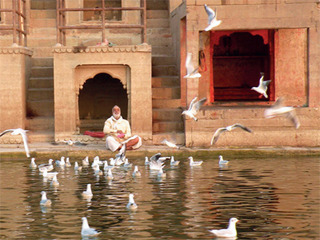 The notion that religious texts have always been around may be rooted in the timelessness of philosophies.
The notion that religious texts have always been around may be rooted in the timelessness of philosophies.
When Draupadi was born from the firepit of her father’s yagnashala, according to the epic Mahabharata, she was fully formed. She had no childhood. No parenting. She was complete and autonomous on the day of her birth, ready to marry and fulfil her destiny.
Many Hindus are convinced that Hinduism was born fully formed, a creation of rishis, and that it has a clear purpose: moksha! In their world, all sacred texts were created thousands of years ago, fully formed. Hinduism has no childhood, no evolution, no transformation even, certainly no foreign or even local influences. Hinduism is seen as a transcendent idea that manifests differently depending on history (kala), geography (sthana), and people involved (patra). This is where historians are divided.
Historians view Hinduism as a product of history, a river with many tributaries that have emerged at different times, in different places. They point out that the word ‘dharma’ is infrequently used before the rise of the Buddha, 2,500 years ago and the word ‘moksha’ becomes important much later, especially following the rise of Hindu monastic orders, a thousand years ago. Chanakya’s Artha-shastra refers to only three pillars of human life: dharma (order), artha (success) and kama (fun). The fourth pillar, moksha (freedom), comes much later. Bhakti, even later.
Orthodox Hindus reject such analysis. It is qualified as ‘Western’ and so invalid. For them all ideas exist in the Vedas. We do find dharma, moksha and bhakti in the Vedas: expressed differently, revealed only to those with faith. To suggest the contrary is to have no faith. Since modern scholarship is based on doubt, even suspicion, they are naturally at loggerheads with orthodoxy, both laying claim to ‘truth’.
Scholars have found that 3,500 years ago, Rig Vedic hymns were composed in all probability around the Indus valley, where once a river called Saraswati flowed, five centuries after the Harappan civilisation had collapsed. Most are convinced that Harappan cities were not Vedic but many have noted Harappan ideas in later Vedic practices, indicating some form of continuity. Three thousand years ago, Vedic hymns were organised and attached to Yajur and Sama Veda, and to the Brahmanas, in the upper Gangetic plains. Two thousand five hundred years ago, Upanishads emerged in the lower Gangetic plains, followed by the composition of the Ramayana, the Mahabharata, and the various Buddhist and Jain lores. All this reached the south around 2,000 years ago, thanks to sages and monks who travelled along coasts and rivers, to the land where Sangam poetry was being composed in Tamil. The South (dakshin, in Sanskrit) soon mirrored the North as cities and rivers came to be identified as Dakshin-Kashi, and Dakshin-Ganga.
In Sangam poetry, we find a pantheon different from the Vedas: Murugan on the mountains, Perumal in the forests, Kottravai on battlefields. These are identified with Kartikeya, Vishnu and Kali. But who made this identification? Brahmins who came from the North, or was it always there, the same idea in different tongues? An earthy passion is found in the Sangam world very different from the transcendent views of Vedic hymns, far more fixed to the earth than the portable yagna. This would eventually influence Hindu thought dramatically.
Many Hindus assume that all Hindu ideas emerged and spread from the North, from the Himalayas and Gangetic plains. Few acknowledge the southern, eastern and western origin of ideas such as bhakti and tantra, with which Hinduism is now identified.
The idea of theism and the submission of God was a revolutionary idea found not in the Vedas, but in the Bhagavad Gita, which is part of the Mahabharata. It found full expression in the Tamil poetry of Alvars and Nayanars, devotees of Vishnu and Shiva, who lived a thousand years ago. Shankara, Ramanuja and Madhva connected Vedic doctrine to this emotion that was anchored on deities who in turn were anchored to mountains and rivers. Ramananada and Vallabha took these ideas north, and inspired the bhakti movement we today associate with Nanak, Kabir, Meera, Surdas and Tulsidas. Sufi thoughts came into India around the same time from Persia, and though Western scholars are quick to point to the foreign influence on Hindu thought, they are equally slow to point to the Indian influence on Arabic, European, South East Asian and Chinese thought.
Hinduism is often called sanatana dharma, which is taken to mean timeless doctrine. This definition has a chauvinistic edge to it, when taken literally. It ignores that all religions assume they existed since the dawn of time. Islam for example insists it came into existence not 1,400 years ago, as historians claim, but since Allah created Adam. Yes, in the Gita, Krishna identifies his teachings so, but equating Vedic thought with timelessness probably became popular only 2,000 years ago, as a push back to the historical Buddha, say historians. Or maybe, one can argue, that Hindu philosophy is sanatan because it anchors itself not on a historical revelation but on an observation of causality (karma), which is indeed timeless.





